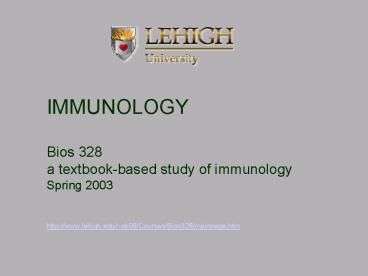Immunogen, antigen, epitope, hapten - PowerPoint PPT Presentation
1 / 28
Title:
Immunogen, antigen, epitope, hapten
Description:
Endogenous: typically peptides derived from any protein; an infected cell ... Endogenous: these antigens are presented by MHC-I; they are seen by T-cells with ... – PowerPoint PPT presentation
Number of Views:726
Avg rating:3.0/5.0
Title: Immunogen, antigen, epitope, hapten
1
(No Transcript)
2
Immunogen, antigen, epitope, hapten
- Immunogen a stimulus that produces a humoral or
cell-mediated immune response - Antigen any substance that binds specifically to
an antibody or a T-cell receptor
3
Immunogen, antigen, epitope, hapten
- All immunogens are antigens but not all antigens
are immunogens
- Some very small molecules called haptens can bind
to Abs or TCRs but they cannot initiate an
immune response
4
Immunogen, antigen, epitope, hapten
- Immunogen a stimulus that produces a humoral or
cell-mediated immune response - Antigen any substance that binds specifically to
an antibody or a T-cell receptor
- Epitope the portion of an antigen that is
recognized and bound by an Ab or TCR/MHC complex
(aka antigenic determinant) - Hapten a low molecular weight molecule that can
be made immunogenic by conjugation to a suitable
carrier
5
Immunogen, antigen, epitope, hapten
- Paratope
- Paratope The site in the variable (V) domain of
an antibody or T-cell receptor that binds to an
epitope on an antigen
6
The key event
7
The basis of immunogenicity
- Foreignness
- Molecular size
- Chemical composition and heterogeneity
- Degradability
8
The key event
- A processed antigen in an MHC is seen by a TCR.
- The TCR asks the MHC, Are you me? and receives
an affirmative answer, Yes. - The TCR asks the processed antigen, Are you me?
and receives the negative answer, No! - Thus, the processed antigen is seen as
not-self, i. e., foreign.
9
The key event
- A processed antigen in an MHC is seen by a TCR.
This viewing occurs in the ternary complex. - The TCR asks the MHC, Are you me? and receives
an affirmative answer, Yes. Here the TCR looks
at the MHC histotope. - The TCR asks the processed antigen, Are you me?
and receives the negative answer, No! Here the
TCR uses its paratope and looks at the epitope.
10
The key event
- A processed antigen in an MHC is seen by a TCR.
- The TCR asks the MHC, Are you me? and receives
an affirmative answer, Yes. - The TCR asks the processed antigen, Are you me?
and receives the negative answer, No!
But what if the TCR asks the processed antigen,
Are you me? and receives the answer, Yes.
TCRs which can see self are eliminated in a
process called clonal deletion. Clonal deletion
assures that TCRs dont see self.
11
(No Transcript)
12
The basis of immunogenicity
- Foreignness
- Molecular size
- Chemical composition and heterogeneity
- Degradability
13
(No Transcript)
14
(No Transcript)
15
Experimental systems
16
Epitopes for B-cells versus T-cells
- By examining myoglobin one can see that the Ags
seen by B-cells and T-cells are different.
B-cells see a continuous or discontinuous series
of amino acids by some circumstance, amino acid
residue 109 has never been a part of an epitope
for any monoclonal antibody yet residue 109 is
always part of the processed antigen seen by a
TCR.
17
Presentation of processed antigen
18
Presentation of processed antigen
19
There are two general classes of antigens
- Exogenous (external)
- Endogenous (internal)
20
There are two general classes of antigens
- Exogenous presented by Antigen Presenting Cells
(APCs). These are macrophages, B-cells, and
some dendritic cells - Endogenous typically peptides derived from any
protein an infected cell displays not-self
proteins and is, thus, an altered self cell
21
There are two general classes of antigens
- Exogenous these antigens are presented in
MHC-II they are seen by T-cells with a TCR and
an associated protein called CD4 - Endogenous these antigens are presented by
MHC-I they are seen by T-cells with a TCR and
an associated protein called CD8
22
There are two classes of T-cells
- TH have CD4 which interacts with MHC-II thus,
CD4 T-cells are MHC-II restricted. - TH cells are helper cells that send signals
(via cytokines and surface proteins) to other
cells of the immune system. The TH cells
function as the brain of the immune system.
23
There are two classes of T-cells
- TC have CD8 which interacts with MHC-I thus,
CD8 T-cells are MHC-I restricted. - TC cells become cytotoxic T lymphocytes (CTLs)
which attack altered self-cells (e. g., infected
cells.) Altered self-cells are also called
target cells. They are the targets for the
CTLs cytotoxicity.
24
Experimental systemsviz. haptens
- Hapten a low molecular-weight molecule that can
be made immunogenic by conjugation to a suitable
carrier
25
Haptens
26
Haptens
27
Summary
- Immunogen
- Antigen
- Epitope
- Hapten
- Foreignness
- Molecular size
- Chemical compo- sition and heterogeneity
- Degradability
28
Experimental systemsviz. adjuvants
- Adjuvants A substance that non-specifically
enhances the immune response to an antigen
- Prolong the presence of the antigen
- Enhance production of co-stimulatory signals
- Induce granuloma formation (i.e., an accumulation
of macrophages) - Non-specifically stimulate lymphocytes































